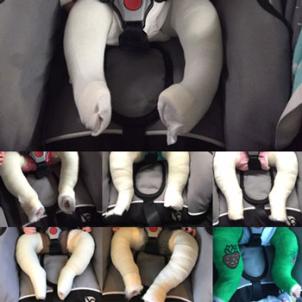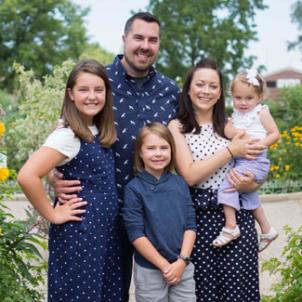
CHLA’s Clubfoot Clinic Takes Shape

Those of you who like the symmetry of things will enjoy hearing that one of the founders of the Clubfoot Clinic at Children’s Hospital Los Angeles was born with the disorder, a birth defect that causes the foot to twist inward and go stiff.
“Like this,” Melissa Bent, MD, says, calling up an image on her laptop that shows the soles of a patient’s little feet turned to such a degree that they’re facing each other.
But as for her career path, Dr. Bent would say her own experience with clubfoot is more coincidental than causal. Destiny didn’t intervene. A mid-20th-century Spanish physician did.
While undertaking a year-long fellowship in clubfoot management, Dr. Bent was introduced to the Ponseti method, a strategy for treating the condition that has transformed outcomes for clubfoot patients. She is only two degrees of separation from the method’s namesake, orthopedist Ignacio Ponseti, who developed the technique in the 1950s years after leaving his native Spain and arriving at the University of Iowa. That same institution is where Dr. Bent completed a second fellowship under Jose Morcuende, MD, who took over Ponseti’s practice after the doctor passed away a decade ago.
Boiled down, the Ponseti method is a meticulous sequence of stretching, manipulating, casting and bracing begun a couple of weeks after birth. Stretching loosens and elongates the stiffened, abnormally short ligaments in the foot that have created the deformity; recasting the foot each week holds the progress made in place; and braces make it so that, once flattened out, the feet don’t revert to their original shape.

In between the casting and bracing phases, most patients require an Achilles tenotomy, a procedure wherein the Achilles tendon, thick and resistant to manipulation, is cut to allow it to regrow to a longer length and provide the ankle with the proper range of motion.
If the course of stretching and casting doesn’t straighten the foot, there are surgical routes to try, but according to Dr. Bent, the Ponseti method has 95% success at achieving a correction.
“We always caution that clubfoot is not a normal foot, so you can’t say the foot is now normal,” she says. “But the goal, as Dr. Ponseti stated, is to get a foot that’s flat, that’s flexible, and you’re able to wear normal shoes without any pain.”
A unique partnership
Born in Jamaica, Dr. Bent didn’t have the benefit of receiving the Ponseti method; it hadn’t yet become the prevailing standard of care. Prior to Ponseti, many doctors would perform major surgeries on a clubfoot and leave the baby with another deformity, or as in Dr. Bent’s case, an overcorrected foot. She has since had multiple procedures to try to address it.
“It is straight, but stiff,” she says. “That’s why it’s painful. I’m active, but I don’t do a lot of running because I physically can’t.”
Dr. Bent’s partner in clubfoot treatment is CHLA orthopedic surgeon Rachel Goldstein, MD, who also has had specialized clubfoot training. Dr. Bent does the casting and bracing, while Dr. Goldstein performs the heel-cord surgery and any other procedure that might be necessary.

“It’s a unique partnership,” Dr. Bent says. “Not many clinics in the country have both surgical and nonsurgical aspects for managing care of clubfoot.”
Over the 2 ½ years since they began the clinic, Dr. Bent estimates the two have seen about 30 to 40 clubfoot babies. It was their expertise in the Ponseti method that brought them their very first patient, a newborn named Merci (pronounced the French way).
Merci’s mother, Tanya, had become familiar with clubfeet through working for Clark Shoes, which during the time it manufactured kids’ shoes used to donate money to MiracleFeet, a charity that supports clubfoot clinics in poorer countries. Part of the funds went toward training health care practitioners in the Ponseti method.
When Merci was born in August 2017 with clubfeet, Tanya and her husband, Greg, read up on the Ponseti method and found that CHLA applied it. That was the closer. “We said, ‘That’s where we’re going,’” Tanya says.
Once they met Dr. Bent and learned of her own personal history with the condition, they were delighted with their decision. “We were sold on her from the minute she walked in and shared with us her story.”
Bracing for the future
Merci, now 2, is on course for the optimal outcome, which would have her out of braces and finished with treatment at age 4 if the feet keep their corrected position.
With clubfoot care, however, there is one caution: the considerable potential for relapse—the foot turning back inward—because the bracing phase overlaps a time, ages 2-4, when a child’s foot is growing rapidly. If that happens, the process must be restarted with weekly foot manipulation and casting.
Tanya is determined to avoid any setbacks. The family has been diligent about adhering to the treatment plan, which now has Merci wearing her braces—or her “boots and bar,” as the family refers to the hardware—only in the evenings.

“Unless she is sick and she cannot have socks on because she has a fever or whatnot, she’s in her boots and bar every night,” Tanya says. “When she’s out of them at 4, we want everything done. I don’t want a 6-year-old back in the casting process.”
On the clubfoot spectrum, Merci’s case started out toward the extreme. “When we first brought her home,” Tanya says, “her feet tucked under her butt, kind of like a little frog. They didn’t even look normal. They almost looked like little flippers. It was really unusual. It was scary.”
With Dr. Bent’s weekly kneading of Merci’s feet to unlock her ligaments, the feet began to steadily straighten. “You could see the progress after every cast. It was like, holy moly! She struggled with crawling, she was delayed in her walking, but now that she’s hit those milestones, oh my gosh—she doesn’t just walk, she sprints everywhere. Does she run a little bit different? Yes.”
That’s a result of underdeveloped lower legs that are a lot thinner than her quads, a natural effect of the condition. Tanya says she’s considering gymnastics and physical therapy as remedies.
It’s uncommon for a relapse of clubfoot to occur after age 5, Dr. Bent says, but it can happen, so just to stay ahead of any regression, she will follow Merci until she is at least 8 to 10 years old.
But that’s what brought her here. She pursued orthopedics, and in particular clubfoot care, because she wanted to witness the results of her work and to see its long-term impact. She has her own phrase for the opportunity to genuinely sculpt a child a better future.
“You get to really see with your hands,’” she says, “and use your hands to make a difference in a very young kid’s life.”
My Child Has What?
Clubfoot, at a glance
What is it? A congenital birth defect in which abnormally short, tight ligaments surrounding the ankle cause a baby’s foot to turn inward. It can strike one foot or both.
What’s the incidence? 1 in 1,000 births in the U.S.
What causes it? Unknown. It runs in families, but no clubfoot gene has been identified. The disorder can exist alone in an otherwise healthy baby or can be one of a series of issues connected to a neuromuscular condition.
How is it treated? The most successful, widespread treatment is the Ponseti method, consisting of a series of stretching, casting, Achilles tenotomy, and braces.
What’s the prognosis? In better than 9 of 10 cases, the Ponseti method has a successful outcome, defined as a flat, straight and flexible foot that causes no pain. If untreated, the foot will remain deformed and walking will be severely impaired.
Famous athletes born with clubfoot: Freddy Sanchez, former professional baseball player; gold medal-winning figure skater Kristi Yamaguchi; retired soccer superstar Mia Hamm; NFL Hall of Fame quarterback Troy Aikman


